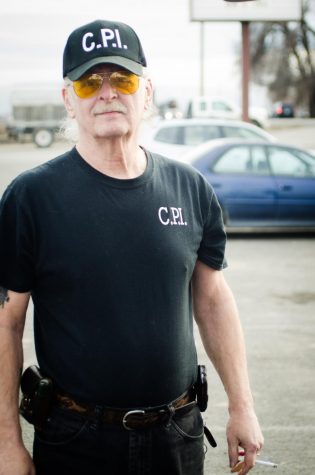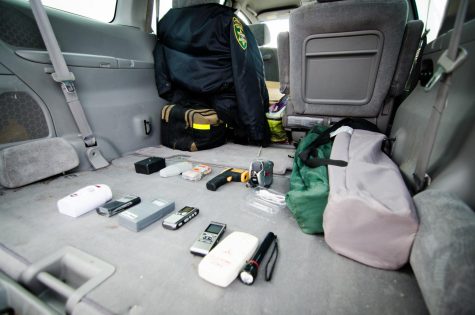Don’t call them the Ghostbusters
Statewide paranormal investigators look to investigate CWU buildings
February 25, 2018
Faces in the window, fuzzy glowing orbs, electromagnetic readings, silhouettes and shadows on the wall – these are just some of the things that paranormal investigators might find when they investigate houses.
Richard Flynn lives a quaint life in Goldendale with his wife, sleeps in past 10 a.m. and visits with his kids often. He volunteers with Klickitat County sheriff’s office in his free time. But most of his time is spent going around to regional residences as a paranormal investigator.

Flynn, 69, and his wife Char, 54, are the co-founders and lead coordinators of Centerstate Paranormal Investigations (CPI), a regional group of six volunteer investigators. The group visits buildings around Yakima that people have claimed are places of paranormal activity, gathering photographic and audio evidence.
Even though the Flynns live in Goldendale, CPI has members that live throughout Washington, including Kennewick, Yakima and Ellensburg.
One of the first things you will find on CPI’s website or Facebook page is a statement so important, it’s even in their “preamble.”
“‘We are not Ghostbusters and we are not exorcists,’” Richard said, stressing the “not.”
According to Richard, it all started in the 1970s when he had a paranormal experience. At the time, he was working for the Seattle Police Department and would later go on to work with the King County Sheriff’s office for 10 years, according to Flynn.
“The only thing King County gave me was a bleeding ulcer and a divorce,” Richard said.
The closer Richard got to his retirement, the more infatuated with the paranormal he became. It was a fascination that would haunt him for years. In 2008, Richard met Char. They would later go on to marry in 2014 and establish CPI the next year. They were living in Yakima at the time.
Richard said that everything they do at CPI is completely evidence based. He said he knows that it may seem wacky from the outside, but once you experience the investigation process it can turn some skeptics into believers.
They contacted us to do a reality TV show and the premise was that we would investigate in the nude.
-Richard Flynn, Co-Founder of CPI
Over the five years that they’ve been active, CPI has completed around 10 investigations. Online, CPI boasts a small catalog of some of the evidence that they find. Pictures of shadow outlines on walls, mysterious orbs caught through digital cameras, electromagnetic readings, short clips of semi-audible language, a short video of a small plush turtle slowly falling off of a couch – all evidence CPI claims is a case for paranormal activity.
“Everything we do is speculated, so some things you sort of have to drive home,” Richard said. He also said that it’s rare that they walk away from an investigation without evidence.
Richard and Char have wanted CPI to investigate some of the buildings on campus at CWU, specifically Kamola Hall. They even reached out to the university, only to get denied.
CPI said that their devotion to the evidence is what differentiates them from the capitalistic-centrism of reality television shows such as Ghost Hunters. According to CPI, they’re all about the craft.
Richard claims that they were approached by some “Hollywood execs” after an NBC-affiliated newscast did a report on CPI.
“They contacted us to do a reality TV show and the premise was that we would investigate in the nude. I can’t think of any groups who would do that,” Richard said. “…Well, maybe one.”
Richard said that CPI has been contacted to do investigations throughout the country, in Alaska, Indiana, Arizona and Texas, to name a few.
People usually find out about CPI from GhostStop.com, a retailer that sells ghost hunting equipment and puts customers in contact with investigators.
CPI is currently unavailable to do most investigations out of state because they don’t have the financial support.
“Everyone wants us to do the work, but no one wants to pay the airfare,” Richard said.
Richard also stressed the importance of the volunteer aspects. CPI will usually take donations, which go towards general expenses, such as gas and equipment, but with all the work put in they don’t see a dime from.
“If you find someone who charges you, steer clear,” Richard said. “Any reputable group will not charge.”
Lola in Kamola
CPI have heard rumors about a student who hung herself in the attic of Kamola Hall a number of years ago. It turns out Richard Villacres, CWU photographer, might have had a run in with the suspected entity.
Lola in Kamola is a university-wide folk tale whose authenticity has been up to speculation. The story goes that a young student, named Lola, hung herself up in the rafter of Kamola’s attic. She was wearing her wedding dress, and many versions of the tale revolve around something happening to Lola’s husband on their wedding night.
In the summer of 2002, Villacres was doing a photo shoot with a model in Kamola Hall during a major renovation. He had his model dress up in a wedding dress. According to Villacres, they were doing a photoshoot that was evocative of Lola. The shoot went fine, Villacres said that nothing went wrong at all. Until he developed the photos.

“At this point in time, I had processed probably a thousand rolls of film and never had an issue,” Villacres said.
When he got his three rolls of film back from processing, two of the canisters hadn’t been exposed. This troubled Villacres until he got to the third rolls of film.
The third roll developed fine, and the photos were exposed. Except for some fogging around the photos and some black bars that went across the exposure. In one of the last slides of the roll, the fog wrapped around all of Villacres’ model except for her dress, which was oddly in focus.
Villacres said that he is a believer of the paranormal, but he doesn’t act on it.
Alex Snyder, freshmen, and Emily Quentin, junior special education major, live on the third floor of Kamola. Quentin said that she’s never experienced anything that she would consider paranormal. Snyder said that she had.
Snyder said that there was one instance when she felt a presence while working on a paper in the LLC Lounge. There was also a couple instances where she would hear footsteps in the middle of the night.
“Some weekday [nights], I’ll hear little kid footsteps, running up and down the steps,” Snyder said. “And then I’ll think to myself ‘there’s no kids in this building.’”


Teresa perez • Jul 26, 2018 at 9:53 pm
I really need help my daughter’s in place. Is an old building was a facility and now it’s getting hot in here and going towards my grandson so I really need help please and thank you my number is 509 8536415
Richard • Mar 6, 2018 at 10:54 am
We just wanted to say Thank You to Eric Rosane for the fabulous article. We had a great time talking to him.
The article was picked up by the ‘Goldendale Sentinel’ newspaper and as a result, someone who read the article has now requested that we do an investigation for them.
Richard
Co-Founder/Investigation Coordinator
CenterState Paranormal Investigations